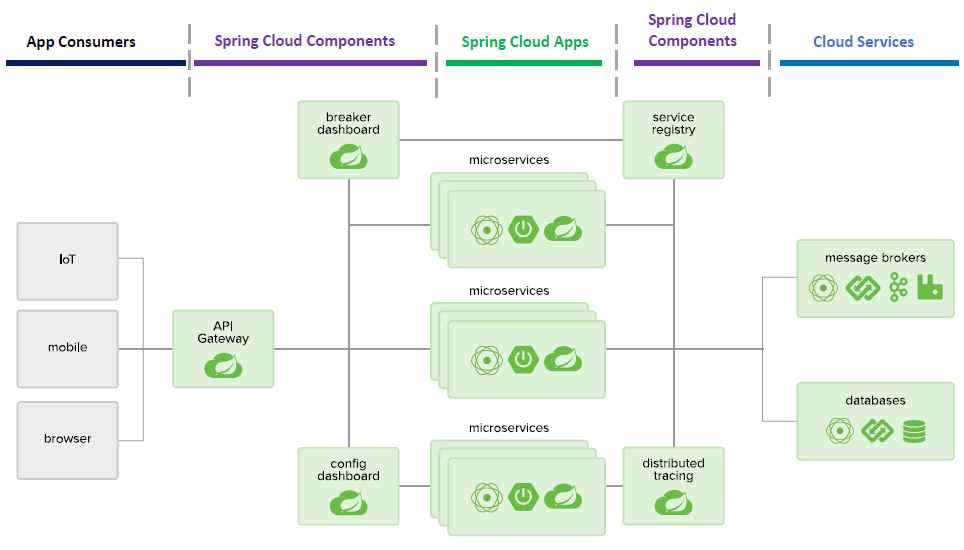5-SECOND SUMMARY:
- Azure Spring Cloud is a fully managed service for Spring Boot apps that lets you focus on building and running the apps that run your business;
- There are numerous benefits of implementing this solution in your business: having simplified infrastructure management; Built-in lifecycle application management.
Cloud-native architecture is an established concept in the IT world. There are numerous reasons to advocate in favour of a cloud-ready environment planned by design. Just to illustrate some of the reasons, we may look into characteristics such as:
- Scalability – where we can scale each service based on load.
- High availability – create more resilient systems.
- Velocity – continuous delivery, team autonomy and unbundled release trains.
- Cost and efficiency – managing infrastructure based in an “on-premises” environment can be overwhelming. Upgrade hardware, maintenance and cost assessment are much more concise and easier to handle in a cloud-based environment.
Among cloud players such as GCP, Amazon, Oracle and others, Microsoft Azure is increasing its effort to enable cloud-native architecture for business through a partnership with Pivotal, bringing their Spring Cloud service under the spotlight. Since Java is a big deal for Microsoft and Spring Boot is an established technology in the market, integrating these two platforms has been made to cope with the microservices architecture challenges.
Common challenges for Spring applications on microservices architecture

Image: Microsoft
A lot of effort is required to manage cloud infrastructure for Spring Boot applications built on a dynamic scalable infrastructure.
Application lifecycles become a complex, painful process. Considering the complicated nature of microservices, it is hard to set up, develop, test and deploy seamlessly. Each Spring application must be aware of the environment system configuration and how to access each cloud service.
Troubleshooting can be really challenging due to the wide variety of resources, such as application logs, databases, message brokers, cloud functions, authentication services, etc. It is hard to monitor and identify scalability needs in a growing complex system.
Azure Spring Cloud
Azure Spring Cloud is a fully managed service for Spring Boot apps that lets you focus on building and running the apps that run your business without the hassle of managing infrastructure too.
Azure Spring Cloud provides all the functionality you need to manage application lifecycle, versioning, deployment, scalability, performance and trace capabilities. Customers can simply deploy their JARs or code, and Azure Spring Cloud will automatically wire their apps with the Spring service runtime. Once deployed they can easily monitor application performance, fix errors and rapidly improve applications. It is integrated into Azure ecosystem and enterprise ready.
Also, if a customer is already using Spring apps, there are zero code changes needed to migrate those apps from another environment to Azure Spring Cloud. The customers only need to orchestrate the pointers for interacting with the data, cache, messaging and directory services in Azure cloud.
There is no need to configure the integration between services since Azure Spring Cloud provides a fully automated service discovery feature.
Azure Spring Cloud facilitates the service bindings with all the cloud components, such as DB, message brokers and UI gateways. Config changes are externalised and made through Azure Spring Cloud configuration controls. No need to redo a deploy process.
Logs and diagnostics are centralised. The owners can query any specific log through the portal using all the capabilities that a tool like ELK can provide. They can even integrate with an external diagnostic tool such as New Relic, App Dynamics or Dynatrace.
The service is jointly developed, operated and supported by Microsoft and VMware. You get best-in-class support from Azure and VMware experts.
Let’s take a deeper look

Image: Microsoft
Starting with its control panel, Azure Spring Cloud facilities the whole process of managing Spring Applications in an Azure microservices ecosystem. Everything is centralised and easy to handle for the owner. Specifically speaking, the Spring Cloud middleware comprehends the following components:
- Code, Build and Deploy lifecycle management
The user can integrate his own development process through the Pivotal build service and Azure Container register. He can manage and build the code through a given CI/CD system based on his own preferences, deploying the built artefacts directly with the containers or generating container images into the Azure container register.
- Configuration
Each Spring application configuration is externalised using Azure config server capabilities where the owner can set up all their parameters, such as server addresses, database connections and even different profiles to isolate environments like development, staging and production. To make changes to the configuration, they only need to carry out modifications through the git repository and then restart those applications related to the desired change.
- Service discovery
Spring applications can take advantage of a discovery service like Eureka to ensure awareness and guarantee connectivity between those applications.
- Gateway Service
ASC provides ingress resources to expose API towards the clients. These API gateway ensure security and reliability, sparing any further specific network configurations.
- Trace and Diagnostics
There are components available such as Azure Monitor, Azure Log Analytics, and Azure Insights, which play a central role as diagnostic tools. The customer can analyse logs to extract more details from runtime issues, analyse distributed application traces and monitor application performance to understand better the root causes of any bug and misbehaviour or where communication bottlenecks are.
All the features available have an essential role in facilitating day-to-day operations at all layers of responsibility.
? From a dev-ops standpoint:
Service discovery and component bindings are facilitated as there is an ecosystem to centralise all the managing operations in a single control panel.
? From the developer’s standpoint:
Easy development, app configuration, testing and deployment give your teams much time efficiency to delivery, from low-budget projects to more complex microservice ecosystems. No need to understand the detail of the infrastructure lying below the system. You only need to focus on developing applications. Even the application wiring and integration can be delegated to the cloud integration service due to Spring cloud’s service registry.
? From a support standpoint:
Logs are centralised, providing a powerful panel to query log entries for applications, databases, message brokers or other components. Trace and application mapping simplifies the understanding of the microservice architecture.
Final Thoughts
It is safe to say that Azure Spring Cloud brings several benefits to customers who want to optimise how they run their business.
Simplified infrastructure management:
- Run your Spring boot apps;
- Scalable global infrastructure;
- Reduce downtime and deployment risks.
Built-in lifecycle application management:
- Spring cloud components are available;
- Deploy source code or build artefacts;
- Automatically wire your app with Spring Cloud infrastructure.
Easily monitor apps:
- Easily monitor performance bottlenecks;
- Gain insight into app dependencies using Azure Monitor;
- Aggregate metrics.
If you want to know more about this technology and/or how to implement this solution in your business, feel free to contact us via email: marketing@xpand-it.com.

Technical Project Manager – Xpand IT















